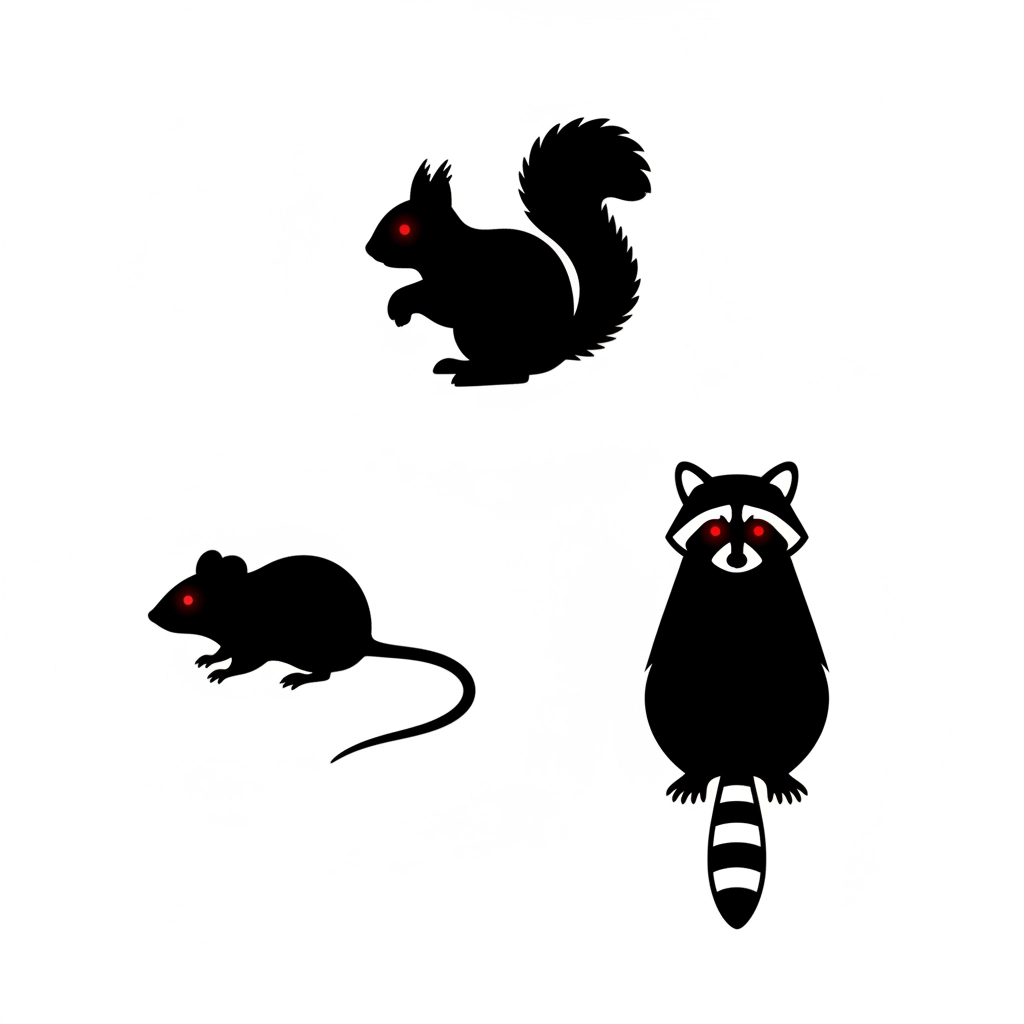The Ultimate Cottage Winterization Guide: Stop Mice, Squirrels & Raccoons Before They Move In
- Targeted Wildlife and Pest Solutions

- Sep 28
- 5 min read
As temperatures drop across Haliburton County, your cottage becomes an increasingly attractive target for wildlife seeking warm shelter and reliable food sources. Mice, squirrels, and raccoons don't just want to visit your property: they want to move in for the winter. These persistent creatures can cause thousands of dollars in property damage, create serious health hazards, and turn your peaceful retreat into a nightmare of chewed wires, contaminated insulation, and structural damage.
The key to protecting your cottage lies in one simple principle: prevention costs far less than removal. Once wildlife establishes residence in your cottage, you're facing expensive professional removal services, extensive repairs, and potential health risks. But with the right winterization strategy, you can keep these unwanted guests out before they ever settle in.
Understanding Winter Wildlife Behavior
Winter transforms wildlife behavior dramatically. As natural food sources disappear and temperatures plummet, animals become increasingly desperate and bold in their search for shelter. Your cottage offers everything they need: warmth, protection from predators, and often, easy access to food sources.
Mice and Rats become especially active during colder months, actively seeking any warm structure they can find. These rodents can squeeze through openings as small as a quarter-inch, and once inside, they multiply rapidly. Beyond the diseases they carry, rodents gnaw constantly to keep their teeth sharp: including on electrical wires, creating serious fire risks.
Squirrels demonstrate remarkable persistence and intelligence when seeking winter shelter. They can leap up to eight feet horizontally and are excellent climbers, making attics and roof spaces their preferred targets. Squirrels cause extensive damage by chewing through virtually any material except metal, and they're particularly destructive to insulation and electrical systems.
Raccoons present the most challenging scenario. These highly intelligent animals are among the most difficult to remove once established. During birthing season, female raccoons actively seek secure spaces like attics and crawl spaces to raise their young. Their waste harbors dangerous parasites and diseases, while their weight and activity can compromise structural integrity.

Conducting a Comprehensive Property Inspection
Your winterization strategy begins with a thorough inspection of every potential entry point. Wildlife doesn't need much space: some species require less than half an inch to gain access to your cottage.
Start with your roofline and work systematically downward. Examine:
Roof edges and eaves for gaps or damaged materials
Chimney systems for missing caps or damaged screens
Vents and exhaust openings for loose or missing covers
Foundation areas for cracks or gaps where utilities enter
Windows and doors for damaged weather stripping or loose frames
Deck and porch areas underneath for access points
Pay special attention to areas where different building materials meet, as these joints often develop gaps over time. Remember that animals can expand small openings by gnawing, so even minor gaps require attention.
Tree and Landscape Assessment
Remove all jumping-off points within eight feet of your cottage structure. Trim tree branches that overhang gutters and rooflines, and cut back shrubs that make contact with walls, porches, or decks. These natural highways provide direct access routes for squirrels and other climbing animals.
Eliminating Food Sources
Wildlife attraction extends far beyond shelter: food availability serves as a primary draw for potential intruders. Systematic food source elimination represents one of your most effective prevention tools.
Indoor Food Management
Store all food items in sealed, rodent-proof containers made of metal or thick plastic. Pay particular attention to pet food, birdseed, and bulk items like flour or cereal. Wipe down counters, tables, and floors regularly, eliminating even small crumbs that can sustain rodent populations.
Keep trash in sealed containers with tight-fitting lids. For areas with persistent raccoon problems, secure lids with elastic shock cords to prevent tipping and raiding.
Outdoor Food Source Control
Remove or reposition bird feeders away from your cottage structure. While you may enjoy watching birds, feeders provide excellent food sources for squirrels and rodents. If you must maintain feeders, place them at least 15 feet from buildings and clean up spilled seed regularly.
Maintain clean outdoor areas, removing fallen fruit, compost piles, and any organic debris that attracts wildlife. Keep garbage areas clean with secure lids, and consider storing trash containers in secured sheds or garages.

Species-Specific Prevention Strategies
Different wildlife species require tailored prevention approaches based on their unique behaviors and capabilities.
Anti-Squirrel Measures
Squirrels present unique challenges due to their exceptional athleticism and persistence. Focus on blocking access points with materials they cannot gnaw through: quarter-inch galvanized steel mesh or metal flashing work effectively.
Install chimney caps if not already present, as chimneys provide ideal nesting sites. Ensure caps have fine mesh to prevent entry while allowing proper ventilation.
Use tree barriers on smooth-barked trees near your cottage. Metal bands around tree trunks prevent climbing while allowing normal tree growth.
Raccoon Deterrent Systems
Raccoon prevention requires understanding their intelligence and problem-solving abilities. Install heavy-duty screening over potential entry points using materials raccoons cannot manipulate or damage.
Apply natural deterrents like cayenne pepper or commercial repellent sprays around potential entry areas. Raccoons have sensitive paws and noses, making these deterrents particularly effective.
Consider motion-activated lights or sprinklers in areas where raccoons commonly approach buildings. These devices startle animals without causing harm.
Rodent Exclusion Methods
Seal small gaps and cracks with steel wool or copper mesh, as rodents cannot gnaw through these materials. For larger openings, use metal flashing or cement-based patching compounds.
Install door sweeps on all exterior doors, ensuring no gap exists at the bottom. Weather-strip windows and doors, paying attention to areas where the building settles and creates new gaps.

Professional Assessment and Intervention
While many winterization measures can be implemented independently, certain situations require professional expertise. Understanding when to call professionals can save both money and safety risks.
When to Call Professionals Immediately
Active infestations: If you discover evidence of current wildlife occupation, professional removal becomes necessary before exclusion work begins
Structural damage: Animals may have caused damage requiring specialized repair before effective exclusion is possible
Health concerns: Bat presence, extensive rodent droppings, or raccoon latrines create health hazards requiring professional handling
Complex entry points: Some access points may be difficult to reach or require specialized materials and techniques
Choosing the Right Professional Service
Look for pest control companies with specific wildlife experience and proper licensing. Ensure they provide comprehensive solutions including both removal and exclusion services. A reputable company will offer detailed inspections, written estimates, and guarantees on their exclusion work.
Professional services become particularly valuable when dealing with species protected by federal or provincial regulations, or when infestations are extensive and require coordinated removal and exclusion efforts.
Maintenance and Monitoring
Effective cottage winterization requires ongoing attention throughout the season. Establish a regular inspection schedule, checking potential entry points monthly during peak wildlife season.
Monitor for signs of attempted entry including:
Fresh gnaw marks on wood or other materials
Scratching sounds in walls or attic spaces
Droppings around potential entry points
Disturbed insulation or nesting materials
Unusual odors indicating animal presence
Reapply natural deterrents regularly, particularly after rain or snow events that reduce their effectiveness.
Your investment in comprehensive cottage winterization pays immediate dividends through prevented property damage, avoided health risks, and eliminated expensive professional removal costs. By implementing systematic prevention strategies before wildlife establishes residence, you protect both your property investment and your peace of mind throughout the winter months.
Remember, the animals trying to enter your cottage during winter are often larger and more persistent than summer pests, making prevention not just preferable but essential for maintaining your cottage's integrity and your family's safety.
Comments